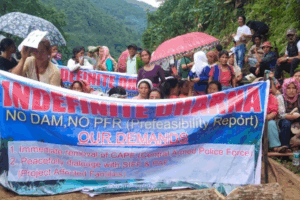Shankar Gopalkrishnan
The Forest Rights Act represented a historic step forward for forest management in India, and it is often hailed as such. However, it did not emerge from struggles for the control over forests alone, but was a product of an ongoing intersection between political conflict, features of Indian capitalism, and the conceptions of “environment” and “development” in India’s political discourse. In that sense, it is not only an “environmental” legislation, but an economic and social one, and one that belongs to a particular political conjuncture, representing both its limitations, and more importantly, its liberatory possibilities. This paper looks at the FRA in this context and explores how it grew out of this kind of politics, being marked both by the constraints of this period, and by the spaces it created for genuinely new conceptions and processes of development. P assed in 2006, the Scheduled Tribes and Other Traditional Forest Dwellers (Recognition of Forest Rights) Act (FRA) remains a flashpoint of struggle and controversy across India. Sometimes these struggles make their way to the national media, sometimes they are not reported beyond the local press, sometimes they are not reported at all. But conflict over control of India’s forests and forestlands is very much a reality in most parts of the country. This law, and contestation over its provisions and implementation, plays a central role in many of these conflicts. When such conflicts are discussed, there are two ways in which they are usually framed. One is as “environmental” conflicts—clashes between the “imperatives” of “environmental protection” and “development.”
The second sees them as conflicts over “displacement” (when large projects are involved) resulting from “acquisition” of land, once again, either for “development” or “conservation” purposes. It is striking that in one of these framings, environment and development are seen as in a zero-sum game, and in the other, considered as reasons for displacing or expropriating people. This contradiction is rooted in the obvious, namely, that both “environment” and “development” mean different things at different times and to different people; these terms acquire their significance from the context. Both these terms “encode” particular conceptions of the relationship between the production process and nature, masking those conceptions behind themselves. The same verbal or linguistic forms can thus be used to represent a whole range of real relationships. In this sense, both environment and development are fundamentally questions of political economy. Nowhere is this more apparent than in the ongoing struggle around India’s forests, and in that sense, these conflicts illuminate India’s political landscape as well. In this paper, I will first attempt a brief examination of the political and economic structures that the terms “environment” and “development” encode in the contentions and struggle on the question of the rights of forest dwellers. This paper has a particular focus on the manner in which the interplay among these forces created the conjunc-ture within which the FRA was framed and passed.
Next, the FRA itself and the current situation in government controlled forest areas are discussed. Lastly, this paper extends the analysis to a few concluding remarks on both the struggle over forests and wider political economy questions. These are the author’s personal views and are not necessarily endorsed by the Campaign for Survival and Dignity. Shankar Gopalakrishnan (shankargopal@myfast mail.com) is with the Campaign for Survival and Dignity. Review of Environment and Development 72 August 5, 2017 vol liI no 31 EPW Economic & Political Weekly India’s oldest and in some ways most detailed “environmental” regulatory regime relates to forests. This regime has its roots in the post-1857 desire of the colonial government to bring in a single, coherent regulatory framework for extraction of timber in British-controlled regions of India. It would have to address both: the need of the empire for cheap timber, and the already burgeoning conflict in India’s forest areas (Guha 1996). This resulted in the Indian Forest Act of 1865, which, after two subsequent iterations, became the Indian Forest Act of 1927. It still remains India’s main forest law. The new law provided for any area of land to be notified as a protected or a reserved forest (“reserved” for colonial use). This was subject to a process of “settlement” of rights, dependent on revenue or forest service officers settling “claims” for rights by local communities. The Struggle over India’s Forests These changes were not merely legal or policy related. They reduced what had previously been territories (areas used and managed for multiple uses under varying regimes of control), to hinterlands that were valued primarily for a single commodity.
In this sense, expropriation was not merely a by-product or a side effect of this legislation; expropriation was its primary intention. The settlement process in reserved forests prescribed under the law was limited to individual lands; all other rights could be converted into “concessions” if the government wished so. Even this process was not carried out in most forests; where it was, the claims of Dalits, Adivasis, and other oppressed sections were either never sought or were ignored. Thus, large areas of forest were declared to be properties of the state. In 1893, in what is now Uttarakhand, all common lands, including pastures and other village common lands, were declared to be state “forests” by the British (Sarin 2005). Shortly afterwards, in Himachal Pradesh, all “wastelands” were declared to be “forests” (Sarin 2005). About 66.4% of its area, including grazing lands and seasonal pastures of nomadic pastoralists, is currently declared to be forestland (FSI 2016). In a 2003 affi davit submitted to the Supreme Court, Madhya Pradesh stated that 82% of its forest blocks had been notified as “forests” without completing any survey or settlement (CSD 2004).
This expropriation, or, to use the more accurate term, this enclosure of common spaces and territories, however, was never completed. The more the colonial authorities attempted to crack down on local communities, the more resistance began to spread. The Bhil uprising in Gujarat at the turn of the previous century is a representative example of several Adivasi uprisings that were triggered by the forcible implementation of forest laws. In Kumaon, forest dwellers resisted so fiercely that the British had to concede a separate arrangement of forest management through democratically elected van panchayats, which exist and function to the present day. In the north-eastern states, the inability of the British to penetrate tribal territories led them to simply make a paper notification extending a classification known as “unclassed state forests” to almost the entirety of the hill areas; a classification that is a problem in these areas up to the present day. After independence, notwithstanding eloquent pleas by the few Adivasi representatives in the Constituent Assembly, the apparatus of forest law was left untouched. Indeed, it was expanded, with the princely states’ forests being incorporated within the then existing forest regulatory regime, in many cases with no settlement at all, such as in the “deemed” reserved forests of Odisha (Sarin 2005).
The resistance, meanwhile, continued. State governments and, after 1980, the central government were compelled to pass executive orders, regulations, and laws to protect rights of forest dwellers or at least to prevent evictions of these communities. These steps, however, remained largely on paper, as they were either ignored or overruled by the forest offi cials. This process had two broad consequences. The first was to produce a contested and complex state of affairs in India’s forest areas. Legal records and state policy constructed an imagined world of enclosed forests “free” of the “burden” of habitation or use, but this is completely at odds with the reality of diverse uses and users. The perpetual low-level conflicts have led to the creation of a corresponding political reality. On the one hand, practically all activity in forest areas—legal or illegal, criminal or civil, local or global, corporate or Adivasi— occurs either with the connivance of or against the will of the state machinery.
This naturally leads state authorities to be both more corrupt and more brutal, even by the low standards of the Indian state in general. This situation also delivered, and continues to deliver benefits for any interest powerful enough to influence state agencies, a point we return to subsequently. On the other hand, resistance could both draw on traditions of collective ownership that already existed, and build on them as a form of defence and security for those under attack. This allows those forms to continue to the present day and to become one of the central features of India’s forest areas; an attribute that is far from being limited to “tribal” areas alone. In sum, the frame of a “state” attacking “people” has a central, deeply material reality in India’s forests. The second consequence was for the elite discourse around “environment.” The forest bureaucracy-centric forms of “resource management” that the colonial laws put in place found a strong resonance with elite discussions of “environmental protection” from the 1970s onwards. In legal terms, the Wild Life Protection Act of 1972, and the Forest (Conservation) Act of 1980, essentially centralised and extended the model of the Indian Forest Act of 1927, except that the latter regime was said to be instituted for “conservation” purposes rather than for timber management. From 1996 onwards, the Supreme Court’s interventions in the Godavarman case continued the same process (Rosencranz and Lele 2008).
Meanwhile, over the same period, a circle of English-speaking conservation organisations and activists such as WWF-India, Wildlife Trust of India, Sanctuary magazine, Valmik Thapar, Bittu Sehgal, and others, came to the fore. These groups and individuals largely began to function through and with the Review of Environment and Development Economic & Political Weekly EPW August 5, 2017 vol liI no 31 73 forest department, seeking more exclusionary conservation models (sometimes varied by limited notions of “community conservation”), and promoting the same in discussions in the English media, international forums, and Indian policymaking corridors. Much of this discourse then penetrated the vernacular media as well. Without necessarily being a conscious political project, this trend amounted to a symbiotic union between a powerful forest bureaucracy and elite environmentalists. As discussed, autocratic forest management had also benefited big capitalists in forest areas, and in this sense, this new union effectively advanced their interests as well. In turn, this distorted the very notion of “environment” in the discourses themselves, for it implied that exclusion and expropriation were central to environmental protection, while democracy, collective action, and resistance were not. Conceptions of ‘Development’
While all these processes were happening in India’s forests, a “paradigm shift” took place in India’s economic framework following the liberalisation process (initiated in the 1980s, and taking a much more wide-ranging form after 1991). These changes were in line with neo-liberal developments elsewhere in the world, and broadly favoured the interests of big business and finance capital. But Indian neo-liberalism has also had distinct characteristics that mark it out from such processes in other parts of the world. Above all (and I am aware that there is a certain irony in writing these words at the present moment, but nevertheless), it has been marked by a curious political weakness. There has never been any party or formation in India that openly espoused anything like the free market ideology that, for instance, Reagan’s Republicans, Thatcher’s Conservatives or Pinochet’s dictatorship did or do. Indeed, every time “reformist” forces have had to confront organised political interests—be it in “reforming” the ration system, labour laws, or foreign direct investment in retail— the former have had to lose the battle and settle for halfway “compromises.”
These compromises have been destructive in themselves, but they have not been the wholesale demolition that the proponents of these reforms desired. The reformists have largely resorted to executive orders, backdoor dilutions to universal provision (through, for instance, “targeting” or the ongoing drive to make Aadhaar mandatory), or measures to ensure that pro-labour or welfare policies are simply not implemented. Thus, as was noted as early as 1999, the most successful Indian “reforms” have largely taken place through stealth, since the forces pushing for them have not been able to win open political confrontations (Jenkins 1999). The reasons for the political weakness of the neo-liberal forces are beyond the scope of this paper,1 but this weakness has had direct consequences for the politics that has been framed around India’s natural resources. This overall weakness coincided with a global trend in this century towards rentierism and profiteering as depressed wages and poverty increasingly reduced demand.2 With their wider policy “reforms” getting increasingly blocked, both international and Indian big capital turned increasingly to natural resource-based profiteering as the way forward.
This shift, which broadly took place during the first National Democratic Alliance (NDA) regime (1998– 2004), was reflected in steps such as easier land acquisition, diluted environment and forest regulations, and accelerated policies for promotion of private mining and power generation. With the corporate sector’s heavy dominance in the media and the overall political discourse of post-1991 India, the corporate priorities rapidly came to defi ne the meaning of the term “development” in the post-2000 decade. Large projects involving speculative or extractive use of natural resources were equated with “development” (through such notions as “employment generation” (even when it was clear that no net employment was being generated) or “infrastructure p rovision”). Then, however, this process ran into a political surprise. With the joint support of the Hindu right and corporate capital, it was widely assumed that the Bharatiya Janata Party-led NDA would win the 2004 general elections and continue the process that it had branded as “India Shining.” In our context, this is particularly relevant as it can be safely stated that if this had happened, there would have been no FRA as we know it today. Instead, the conflict in forest areas would have intensified and deepened, but most likely continued in the same manner as earlier.
But that is not what happened. Instead, defying all expectations, including those of its opponents, the NDA lost the 2004 general elections. This was not a defeat for either neo-liberalism or the Hindu right as such. The neo-liberal “reformist” ideology remained the most powerful force in the new government, but it was clear that on its own, this was not enough to win popular support in India. While the incoming Congress-led government remained pro-corporate and pro-big business in its orientation, it was also faced with an ideological conundrum that neither it nor its corporate backers had any ready solution for: what form of neo-liberalism in India would be politically sustainable? The result was the opening of a political space, roughly between 2004 and 2006, that was reflected in the creation of institutions like the National Advisory Council and the Coordination Committee between the United Progressive Alliance (UPA) and the left parties (who supported it from outside). This space was tightly constrained, however.
The first constraint was the continuing power of big capital. Demands that directly threatened individual capitalists’ interests would not go far (as epitomised by the fate of reservations in the private sector that was also a part of the common minimum programme of the UPA). Moreover, they would also continue to push agendas that suited rentiers and resource-grabbing big corporations (such as the Special Economic Zones Act, 2005). But, the failure of India Shining meant that generalised neoliberal ideology was no longer strong enough to block other measures, especially those that, in one way or another, were “new” to mainstream Indian politics. A loose, motley coalition of “people’s movements,” left parties and progressive forces proceeded to move into this REVIEW OF ENVIRONMENT AND DEVELOPMENT 74 AUGUST 5, 2017 vol. III no 31 EPW Economic & Political Weekly space, and it was this process that produced a sudden crop of “new” legislations and policies, in particular, the Mahatma Gandhi National Rural Employment Guarantee Act, the Right to Information Act, and of course, the FRA.
All these laws were marked by the particular constraints of this political conjuncture. Making of a New Politics around Forests When the UPA government committed to protecting forest dwellers’ rights in its common minimum programme,4 it was not yet clear if this would take the form of a new law. That demand emerged from a series of meetings and mobilisations by forest dwellers’ movements in 2004, leading eventually to the formal decision to frame a law in January 2005. The details of what happened next are beyond the scope of this paper,5 but broadly, three political groupings coalesced around this issue. These three continue to form the landscape around forest policy in India even today. First was forest bureaucracy, and along with them, a section of the elite environmentalists who had long come to see India’s conservation policy through the forest department’s eyes. This group was implacably opposed to any change in forest policy at all. They attacked the proposed new legislation as a profligate giveaway of forestland, an argument that some of these NGOs continue to make to this day.
They also deployed colonial tropes of the need to protect forests against irresponsible encroachers and destructive local communities. In the first years of contestations around the new legislation, particularly 2005 and 2006, this argument found a great deal of resonance in the English media, since it fit so cleanly into the definition of “environment” that had so long dominated elite policy discourses. As a result, article after article claimed that the law would “distribute” India’s forests in a “wasteful populist gesture,” ignoring the entire issue of expropriation and autocratic governance (see, as a representative example, Singh 2006). Without making any explicit reference to the interests of resource-grabbing large capitalists, this group effectively defended these interests precisely by being silent about these forms of environmental destruction. The second was a larger alliance of Adivasi and forest dwellers’ movements.7 For these groups, the forest bureaucracy and the colonial model of forest management was the enemy. They saw potential in the new law as a weapon towards more democratic and collective control over forests. For many of these organisations, this was also linked to the struggle against intensifying resource grabbing by big capitalists. In time, these groups found support from strong sections of the left parties and from within the Congress. The third force was a set of bureaucrats within the government but not from the forest department, who drew their power from the corporate–political core of the ruling establishment. They sought a “moderate” law to address the popular mobilisation, but one that would simultaneously not threaten the existing structure too deeply.
This third group’s goals best fitted with what the UPA was trying to do: create a model of “reforms with a human face,” as the then Prime Minister Manmohan Singh once put it. In this view, the paramount interests of state agencies and big capitalists in accumulation through forests was not to be threatened, and the interests of the forest bureaucracy were also not to be touched. As an internal note from the Prime Minister’s Office put it in 2006, there was “no need to indulge in communitarian wishful thinking,” and instead the goal of the new law should primarily be to “reduce harassment of tribals.” In the initial stages of framing of the law, the first force (forest bureaucracy) was successful in delaying the process. But, as a result of the contradictory political situation created by the 2004 elections, this force lacked the support of either the political leadership of any party, or the corporate sector (which had simply not yet figured out what this law might mean). The third force saw the forest rights issue as an “easy” concession that would win popularity without threatening the neo-liberal order too deeply. But they could not fathom that the issue was consider-ably broader and more powerful than they realised.
With the second and third groups both demanding a new law on forest rights, a joint drafting group was set up on 19 January 2005. With the contributions of people like Madhu Sarin and Pradip Prabhu, a new draft law was framed, titled the Scheduled Tribes and Forest Dwellers (Recognition of Rights) Bill and known informally as the “Forest Bill” or the “Tribal Bill.” The draft had specific provisions on community rights, collective management of forests, and the empowerment of the gram sabha (village assembly) in determining rights. But once this draft was made, sensing that the issue was beginning to spin out of their preferred limits, the central bureaucracy (the third force) intervened and considerably diluted this draft. Now that they had crossed the stage of their common interest—the creation of a new law—from May 2005 onwards, the second and third forces began to clash with each other over the content of this law. This clash reached its peak after the law was referred to a Joint Parliamentary Committee (JPC) in December 2005,8 an arena where the second force was dominant. The essentially political conflict between these social forces then played out as a contest over almost every word of the new law. In particular, certain issues emerged as key flashpoints. For instance, the third force tried to exclude non-tribals from the law in order to restrain its scope. The JPC was not impressed and strongly recommended their inclusion. Community rights became another flashpoint in the contest with an attempt by the same third force to limit the law to individual and minor forest produce rights only for tribals. This too was rejected by the JPC.
The cut-off date for recognition of rights was initially set at 1980; the JPC advanced it to 2005. Even after the JPC submitted its report in May 2006, this struggle went on for a further year and a half. At each stage, the contest was fierce. The third force, repeatedly resorted to blatant sabotage; officers in the Lok Sabha secretariat attempted to dilute the JPC’s report behind the chairman’s back. Ministry officials leaked false details to the press (a strategy REVIEW OF ENVIRONMENT AND DEVELOPMENT Economic & Political Weekly EPW AUGUST 5, 2017 vol liI no 31 75 borrowed from the foresters), and finally, the ministry rammed through amendments to the JPC’s final bill by tabling them literally half an hour before the parliamentary debate was to begin on 15 December 2006. The framing of the rules and the notification of the law saw more such sabotage and struggle, eventually being notified into force only on 31 December 2007. The key provisions of the FRA are marked by this phase of conflict more than any other. For instance, non-tribals are indeed included, but subject to an absurd condition of having to establish residence in a forest area from 1930 (this being one of the last minute amendments).
Key provisions for habitat rights for particularly vulnerable tribal groups and rights of pastoralists were included in the law, but the provisions only state that these rights exist, and neither the rules nor the act provide any clear definition of the method of their recognition (subsequent clarifications, won through later struggles, have added clarity on these points). Penal provisions for violations of the law were badly diluted, with the inclusion of a mandatory 60-day notice to a state-level monitoring body before a first information report can even be registered for violations of the act. This, however, does not mean that the FRA is a “weak” law. All laws are marked by political struggles over their text and meaning. Precisely because the FRA emerged from such fierce contestation, it has also included more powerful provisions than any previous forest law in India’s history. For the first time, forest dwellers have a statutorily recognised right to protect and manage forests. Rights are to be determined through a process starting at the village. In this sense, the political import of the FRA goes well beyond its text; it offered the possibility of a new system of forest management, and implicitly a new model of resource management, that went beyond the prior dominant discourses of both “environment” and “development” discussed earlier. The Ongoing Struggle over Forest Management In the years since, the landscape has changed in multiple ways. With the financial crisis of 2008 and the UPA’s second election victory in 2009, the corporate backlash began, and the political space of 2004–06 was quickly closed (though some of its themes carried forward in a far more weakened form, resulting in the new land acquisition and food security acts).
The victory of the Bharatiya Janata Party-led NDA in 2014 in a sense marked the culmination of this process and the return of the 1998–2004 model of an alliance between Hindutva and corporate power, this time in a much more aggressive and powerful form. From 2011 onwards, rentier-driven resource speculation became the essential leitmotif of reforms for the entire big business lobby in India. Thus, supposed “difficulties” in procuring environmental and forest clearances that did not in fact exist, became the fodder in the English-language press campaign to point at the UPA’s supposed “policy paralysis.” The Modi government promised precisely this: faster clearances, faster permissions, and “ease of business,” in all its claims on “development.” However, the very creation of the FRA had changed the landscape in the other direction as well, and in a far more lasting fashion than its opponents suspected. When the NDA won the parliamentary elections in 2014, its vocal English media supporters expected it to eliminate the employment guarantee, forest rights, and land acquisition (of 2013) acts, and to roll back almost all the changes of the UPA phase to return to the domain marked by a “pure” neo-liberal economic policy.
The NDA, thus far, has not been able to do any of those things. Instead, it has returned to Indian neo-liberalism’s oldest strategy, and attempted to destroy these measures through backdoor institutional weakening and deliberate sabotage. In the case of the FRA, this has greatly strengthened the hands of the first force mentioned before, that is of the forest bureaucracy. Since 2014, a series of steps have been taken to eliminate the key provisions of the FRA. The requirement for the consent of the gram sabha before diverting forestland for large projects was in any case not implemented even by the UPA, and there has been a continuous effort to dilute it in the last three years. The forest bureaucracy has also hit on its most successful strategy so far, which is simply to create new policies and institutions in complete disregard to the FRA. Thus, state governments have passed new “village forest rules” for the forest department-controlled “participatory management” with no reference to the FRA. 9 The recently passed Compensatory Afforestation Fund (CAF) Act, 2016, provides for huge funds from diversion of forests to be simply handed over to state forest departments for a wide variety of activities. Since many of these activities will occur in forests over which forest dwellers have rights under the FRA, the opposition strongly demanded the inclusion of protections requiring that spending of money under the CAF Act should not result in infringement of rights. But the government managed to overrule them, and the version of the bill that was eventually passed does not contain a single provision referring to the FRA.
Thus, it is likely that these funds will be spent as if, once again, the FRA does not exist, empowering forest officers to use plantations to take over individual and common lands. In this sense, having lost their battle to stop the law entirely, the forest bureaucracy is now trying to regain its power through the back door. In this, they are broadly supported by both the political leadership and the corporate sector. The third force, that is, the non-forest bureaucracy, has thus vanished as an independent actor at the national level. It lives on in the state governments, where political leaders (for instance, Naveen Patnaik of Odisha) sometimes seek to invoke the FRA as a tool for popularity, while simultaneously either ignoring its implementation or blocking it. In other states, such as Uttarakhand and Himachal Pradesh, the forest bureaucracy has managed to retain its dominance to the extent that no formal implementation has taken place. But it is the activities of the second force—social movements, local communities, mass organisations, and forest dwellers—that have the most long-term significance. The FRA has percolated across the entire country, and examples abound Review of Environment and Development 76, August 5, 2017 vol liI no 31 EPW Economic & Political Weekly of how it is being used in defence of resource rights, in struggles against projects, and in efforts to build new models of development and collective resource use. For instance, in Goa, it was used by Adivasis of the Velip community to halt forest department’s attacks against cashew plantations (Gaonkar 2012). In Manipur, it is being invoked in the ongoing struggles against the Mapithel and Tipaimukh dams (Kipgen 2015).
In Kerala, it is the main weapon of Adivasi communities fighting against the Athirappilly hydroelectric project (Narayanan 2015). In the Dooars region of West Bengal, the Uttar Bango Bon-Jon Shromojivi Manch compelled the state forest department to stop all tree felling in their villages until the department received consent from the gram sabha (Ghosh 2015). In MP, Baiga Adivasis became the fi rst community in the country to secure habitat rights under the FRA, and are attempting to use it to stop the seizure of their land in the name of a wildlife corridor (Chakravarty 2016). Further, after a period of almost seven years since the enactment of FRA in which barely any community forest resource rights has been recognised in India, in the last three years mobilisation on these issues has resulted in a steadily growing number of recognised community forests. More than 1,350 community forest rights titles10 have been issued in Gadchiroli district in Maharashtra alone, and more than 1,000 of these villages have earned crores from tendu patta sales (and, in a smaller number of villages, from bamboo) (Bhattacharya 2016). In that sense, the FRA’s original purpose—as a weapon of struggle—is being vindicated every day.
Are these “environmental” or “developmental” victories? Framed in this way, the only possible answer is that they are both. The trajectory of the forest rights struggle reflects many of the basic realities of India’s political economy, thrown into sharp relief by the particular configuration of Indian capitalism in forest areas. This configuration has produced a brutal, unjust face of the state that has been continuously visible for over a century. Nowhere else, hence, was collective production and a genuinely different discourse of both “environment” and “development” possible. The FRA sprang from this history, and was then shaped by the larger contradictions of India’s present-day political economy; contradictions which, today, are among the central fault lines of India’s politics. Hence this law now sits at the intersection of several of the most important and powerful forces shaping India, and it is thus, hardly surprising that it is so fiercely contested. That contestation will continue, and will grow. Contained within it are the seeds of a genuinely different, collective and democratic model of the use and conservation of nature, and of the livelihoods of people. The next stage of that struggle will be something more radical, and all that can be said now is that whatever that is, it will push the boundaries of both “environment” and “development” well beyond the way those terms are often understood today.


















